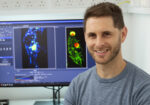

Starts as a Group Leader January 2025
Phagocytic cells, such as macrophages and microglia, are essential for clearing extracellular targets like dead and infected cells, protein aggregates, lipoproteins, synapses and microorganisms. The human body clears approximately 200 billion dead cells daily, underscoring the importance of these cells in maintaining health. Ineffective clearance can lead to conditions that include atherosclerosis, neurodegeneration, and macular degeneration.
Our research group aims to uncover the molecular mechanisms that allow phagocytic cells to find, engage, digest, process, and manage these materials throughout their lifespan, which can span months to years. Phagocytosed materials are encapsulated in phagosomes that fuse with lysosomes to form degradative phagolysosomes. After degradation, the resulting molecules must be integrated into cellular metabolism, disposed of via paracellular export, or detoxified. Additionally, the membranes of phagolysosomes must be resorbed and recycled to continuously process incoming materials. These processes are critical, as evidenced by lysosomal storage disorders (LSD), where improper export of catabolites disrupts cellular function.
Despite its significance, the mechanisms and dynamics of phagolysosomal resolution are not well understood. Depending on your interests, we offer a variety of projects focused on membrane resolution, organelle physiology, metabolite transport, and the biological underpinnings of diseases such as atherosclerosis and Alzheimer’s disease.
As a doctoral trainee, you will work in the interphase of cell biology, genomics and immunology. For this, you will learn and engage in multidisciplinary approaches, utilising high-throughput CRISPR-based genetic screening, advanced light microscopy and image analysis, flow cytometry, and cell physiology assays. For further information please contact Roni -email: rlevinko@mrc-lmb.cam.ac.uk
References
Levin-Konigsberg, R., Montaño-Rendón, F., Keren-Kaplan, T., Li, R., Ego, B., Mylvaganam, S., DiCiccio, J.E., Trimble, W.S., Bassik, M.C., Bonifacino, J.S., Fairn, G.D., Grinstein, S. (2019)
Phagolysosome resolution requires contacts with the endoplasmic reticulum and phosphatidylinositol-4-phosphate signalling
Nat Cell Biol 21(10): 1234-1247
Levin-Konigsberg, R., Mitra, K., Nigam, A., Spees, K., Hivare, P., Liu, K., Kundaje, A., Krishnan, Y., Bassik, M.C. (2023)
SLC12A9 is a lysosome-detoxifying ammonium - chloride co-transporter
bioRxiv
Hsu, C., Lin, W., Seshasayee, D., Chen, Y., Ding, X., Lin, Z., Suto, E., Huang, Z., Lee, W.P., Park, H., Xu, M., Sun, M., Rangell, L., Lutman, J.L., Ulufatu, S., Stefanich, E., Chalouni, C., Sagolla, M., Diehl, L., Fielder, P., Dean, B., Balazs, M., Martin, F. (2012)
Equilibrative nucleoside transporter 3 deficiency perturbs lysosome function and macrophage homeostasis
Science 335(6064): 89-92
Levin, R., Grinstein, S., Canton, J. (2016)
The life cycle of phagosomes: formation, maturation, and resolution
Immunol Rev 273(1): 156-79
Mylvaganam, S., Freeman, S.A. (2023)
The resolution of phagosomes Immunol Rev 319(1): 45-64
Hu, M., Zhou, N., Cai, W., Xu, H. (2022)
Lysosomal solute and water transport
J Cell Biol 221(11): e202109133